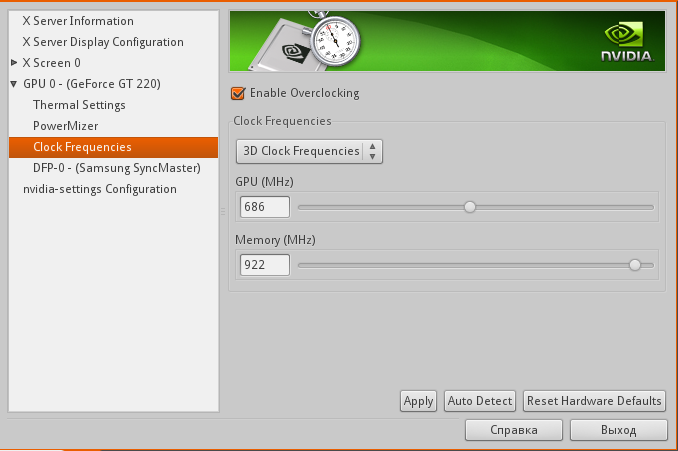The way to accelerate the Nvidia video card in Linux
I want to talk about one way to add "parrots" to your video card.
I don't often play games, and therefore the performance of a video card has always played a secondary role for me. But no matter how occasionally bumping into some interesting release of the game, I can not help but install it and play, and it can be useful to get away from the rush. Since I am the owner of a far from top video card on the Nvidia chip, the issue of overclocking a video card was quite acute for me. It seems to be no problem if it were not for one BUT. If for Windows users there is a zoo of software designed for overclocking video cards, then in Linux there was no such abundance. Even more than that, all the variety is limited to just one NVClock utility - for Nvidia cards, and also one AMDOverdriveCtrl utility - for AMD / ATI. On NVClock, another disappointment awaited me - the last update of the utility was in 2009, and it doesn’t support my card accordingly. Nevertheless, the solution turned out to be much closer, namely in the driver itself. The fact is that the Nvidia control panel has its own means to control the frequency of the GPU and the bus, but due to security reasons, these settings are hidden from the naughty hands of users. Next on how to get to the settings.
In order for the necessary items to appear in the control panel, we need to open the X server configuration file to add the line: Option “Coolbits” “1” to the Section Section “Device”, for me it looks like this:
Now after the reboot, additional settings will appear in the control panel:
')

Go to the Clock Frequencies tab and set the “Enable Overclocking” checkbox, after which it will be possible to manually set the frequencies for the GPU and memory. After you select the optimal parameters, remember them - because after the reboot, all the settings will fail, and it will be necessary to set everything up again. To avoid this, I created a script with this content:
After that, he saved the file in the home directory and made it executable. Now it remains to register the file in autorun any way you want and the settings will be set automatically when the system boots.
Thanks to everyone who read. I hope that this information will not be useful to anyone.
Foreword
I don't often play games, and therefore the performance of a video card has always played a secondary role for me. But no matter how occasionally bumping into some interesting release of the game, I can not help but install it and play, and it can be useful to get away from the rush. Since I am the owner of a far from top video card on the Nvidia chip, the issue of overclocking a video card was quite acute for me. It seems to be no problem if it were not for one BUT. If for Windows users there is a zoo of software designed for overclocking video cards, then in Linux there was no such abundance. Even more than that, all the variety is limited to just one NVClock utility - for Nvidia cards, and also one AMDOverdriveCtrl utility - for AMD / ATI. On NVClock, another disappointment awaited me - the last update of the utility was in 2009, and it doesn’t support my card accordingly. Nevertheless, the solution turned out to be much closer, namely in the driver itself. The fact is that the Nvidia control panel has its own means to control the frequency of the GPU and the bus, but due to security reasons, these settings are hidden from the naughty hands of users. Next on how to get to the settings.
To business
In order for the necessary items to appear in the control panel, we need to open the X server configuration file to add the line: Option “Coolbits” “1” to the Section Section “Device”, for me it looks like this:
Section "Device"
Identifier "Card0"
Driver "nvidia"
Option "RenderAccel" "True"
Option "AddARGBGLXVisuals" "True"
Option "Coolbits" "1"
BusID "PCI:3:0:0"
Option "NoLogo" "True"
EndSectionNow after the reboot, additional settings will appear in the control panel:
')

Go to the Clock Frequencies tab and set the “Enable Overclocking” checkbox, after which it will be possible to manually set the frequencies for the GPU and memory. After you select the optimal parameters, remember them - because after the reboot, all the settings will fail, and it will be necessary to set everything up again. To avoid this, I created a script with this content:
#!bin/sh
#
nvidia-settings --assign "[gpu:0]/GPUOverclockingState=1" &&
#2D
#nvidia-settings --assign "[gpu:0]/GPU2DClockFreqs=*,*" &&
#3D .
nvidia-settings --assign "[gpu:0]/GPU3DClockFreqs=679,831" &&
nvidia-settings --assign "[gpu:0]/GPU3DClockFreqs=686,922" &&
# (Prefer Maximum Performance)
nvidia-settings --assign "[gpu:0]/GPUPowerMizerMode=1" &
After that, he saved the file in the home directory and made it executable. Now it remains to register the file in autorun any way you want and the settings will be set automatically when the system boots.
Thanks to everyone who read. I hope that this information will not be useful to anyone.
Source: https://habr.com/ru/post/130284/
All Articles